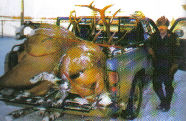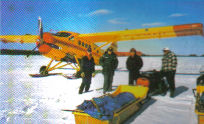MANITOBA CONSERVATION 
MANITOBA became a province in 1870 but control and protection
of all natural resources remained with the federal government
until July 15, 1930. Forestry issues were administered
by the Dominion Forest Service, protection of game by the
Department Agriculture and fisheries matters the Federal
Department
of Marine and Fisheries. Today's natural resource officers
originated from these three main branches of the federal
government.
The largest was the Dominion Forest Service. The first
Dominion Land Act was enacted in 1872 and was followed
by the Forest
Reserve and Parks Act in 1911. With the transfer of natural
resources to the province in 1930 a Provincial Forestry
Service was formed. It took over the administration of
forestry affairs
on crown land. This included fire protection, timber harvesting,
reforestation and the administration of summer resorts.
Many of the Dominion Forest Officers were given the option
of
remaining in the federal service or working in the newly
formed Provincial Forest Service. Many chose to work for
the new provincial organization bringing with them the
methodology and field practices in use at the time. The
Forest Service,
as originally organized, was headed by the Provincial Forester
and the province was divided into four forest districts,
each headed by a district forester. The forest districts
were again divided into ranger districts, each with a forest
ranger. In 1960 the province had a field staff of 50 forest
rangers.
In the early days travel in the district was done mainly
by horse, walking or in the winter months by skiing and
snowshoes. Even in the early days field staff appeared
to bear the brunt
of government restraint as noted in a transfer letter to
a forest ranger from the district forester which read as
follows: "Please be advised that your effective date
of transfer from Lac du Bonnet District to the Garland
District has been confirmed. Since Garland District is
somewhat smaller
and can be traveled by snowshoes you will no longer be paid
$1.50 per month for the use of your horses."

The forest ranger busy in the winter checking sawmill sites
and logging camps in his district. Often he
was gone for several days at a time as he would overnight
at certain
|
camps before he made his
circuit. In the summer his work turned to fire fighting
as noted by one young forest ranger stationed at Mafeking. "Ray
was eager to learn but knew little of firefighting at the
time. He left camp with 106 local firefighters, but the
fire cut off their route and they slept under the trees.
Shovels and axes were their only tools and travel was by
foot from the nearest lake where a
plane had dropped them off. At 7:00 am the
next morning Ray turned his radio on and his supervisor
called. "Well
Ray you can start buying cigars, your wife Pat had a baby
boy last night." Ray wept with joy, however, it would
be two more days before he could leave the bush to see
his son.
The Wildlife Branch was next in field officer numbers.
In 1876 Manitoba proclaimed it's first Game Preservation
Act.
The Game Protection Act of 1879 provided for the appointment
of voluntary guardians to enforce provisions of the act.
By 1883 local game guardians were at work in Manitoba.
but it was not until 1902 that a Provincial Game Guardian
was
appointed. He was C. Barker and he occupied the position
until 1919. In 1905 an additional employee was added and in 1909 John Keyes and
William H. Joyce were hired as deputies.
By May 1, 1920 prosecution of game matters
were handled by CANADA seven inspectors
and game guardians of the Manitoba Provincial
Police. That changed on July 15, 1930
when the Department of Mines and Natural Resources
took over the control and
administration of forestry, fire protection, game and fisheries.
Game management personnel transferred from
the Department of Agriculture to this
new department. The new game branch
consisted of a director, chief game
guardian, eight permanent and four
temporary game guardians. Game guardians
carried out continual patrols. The
main problems involved closed season hunting and poaching
in game preserves and bird sanctuaries. The director of
the game branch at
that time, A. G. Cunningham, wrote: 'Efficient
game enforcement has been rendered very difficult owing to the number of game
guardians that could be employed due to the present economic situation."
Game wardens often worked alone or in isolated and remote communities. Since
there was a lack of efficient communication with their supervisor they were
required to keep a very detailed daily log. In one annual report it stated
that game guardians
traveled a total of 196,772 miles to patrol their districts. They used dog
teams for 1,376 miles, horses for 3,467 miles and foot for 8,912 miles.
|

